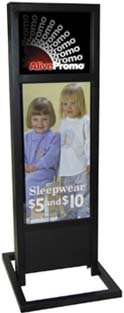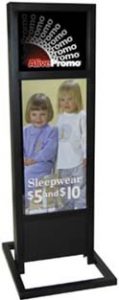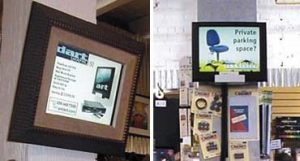Electric Signs
Killing the Moose
How to get started in digital messaging
Published
18 years agoon

There’s no point in getting people excited about something they can’t spend money on," says Lou Giacalone, senior vice president of Adspace/CoolSign, a major player in digital-messaging systems and developer of the CoolSign content-management software. I agree with him. Giacalone had admonished his peers at the CAP Ventures Narrowcasting Conference to not over-promote the capabilities of electronic- digital signage until they could deliver. After enduring the ubiquitous vaporware claims that marked the first decade of wide-format digital imaging, I think no one agrees with Giacalone more than I do. And yet, reviewing Giacalone’s comments in preparation for this column made me feel vaguely uncomfortable. Why? I quickly identified the emotion as guilt. Is it possible that I had been getting people excited about something they can’t spend money on? After I thought about it objectively, my conclusion was an unequivocal yes and no. Upon further review of this series, I acknowledge that some of what I’ve been telling you since April has been theoretical or speculative, if you’re looking to get your feet wet in electronic-digital signage. The high-profile, digital-messaging installations on which we’ve reported are generally big-ticket, networked projects, with price tags in the hundreds of thousands of dollars. You don’t cut your teeth on these jobs. I also confess to flights of futuristic fantasy — we previewed such technologies as OLEDs, which won’t realistically hit the streets as real signs until several years down the road. But I have forgiven myself, and you should, too. A certain amount of visionary speculation is necessary in order to plan for the future, and it’s definitely more fun than figuring out how you’re going to pay the bills today. But, in this installment, I will make amends by sharing information about how you might actually begin to move into the electronic-digital-signage paradigm without risking everything. I understand this challenge better, partially via your response (a balanced mixture of interest and frustration) to these columns. The frustration results not from any over- whelming skepticism regarding the ultimate adoption of electronic-digital-sign technology, but rather from the lack of a clear starting point. The here and now As of today, a small pantheon of digital-message entrepreneurs will compete with each other for a small universe of big customers. The customers tend to be such deep-pocket corporations as national retailers, fast-food chains, airports and casinos. These initiatives require high levels of expertise and a selling cycle that ranges from a year to 18 months. Throw in the tepid-economy factor, and it’s not surprising that the competing companies aren’t making money. In these large-scale projects thus far, sign companies have participated only as installation subcontractors. Yet, as I previously suggested, the sign industry should have the inside track when introducing electronic-digital-sign messaging’s potential to the non-corporate and less-corporate markets. "Sign companies are the front-line contacts with small to medium customers," agrees Tony Dillon, vice-president of consumer message at Clarity Visual Systems. "And they need to find a solution they can sell." Clarity Visual manufactures large-format, projection-display screens, while serving as a globally successful systems integrator. As one of the original, digital-messaging trailblazers, the Wilsonville, OR-based outfit has wired large-scale, digital-sign systems in airports, fast-food chains and retail corporations internationally. But, as with other companies that currently own the deep expertise to implement this emerging technology, Clarity doesn’t have the sales and marketing infrastructure to reach a broad spectrum of smaller customers. But you do, and apparently Clarity and other digital-sign-messaging players are seriously responding. In the past, the electronic-digital-sign-community systems integrators have lukewarmly partnered with sign companies and other graphics providers. The implied caveat is that a sign company should already have contracted an interested customer. Unfortunately, any sign user unfamiliar with big-time brand marketing and advertising probably doesn’t know much about digital messaging — the clues aren’t obvious unless you’re looking for them. Most businesses don’t connect the LCD screen at the grocery checkout or on cell phones where they would interface with changeable-content visual communications’ potential. In other words, your customers can’t request digital-messaging systems if they don’t understand their possibilities for their business. They’ll become enlightened only if you teach them…or wait for someone else to do it. As a cliché, this dilemma is worse than the chicken and the egg. It’s a Catch 22. Moose stew In a famous Canadian recipe for moose stew, the first step is "kill a moose." Similarly, if you’re planning to make your fortune in electronic-digital signage, you must first have something to sell. And, just about in the nick of time, turnkey, modestly priced digital-display systems that are easy to install and manage are appearing on the radar. But before we get to the specifics, we should define what comprises a "digital-messaging system." Even a basic, single-face, electronic-digital-sign solution requires three bare-bones components: the display interface or appliance, a player or driver to make the display work, and content. Although not the most important component, the display interface is the most obvious place to begin. In this column, we’ve discussed several types of electronic-display technologies. But now that it’s time to spend your money, let’s get real. What are our current options? Organic light-emitting diodes (OLEDs) present the most fascinating possibilities of output technologies, but practical opportunities for mainstream sign applications won’t appear for several years. For now, forget OLEDs. Slightly more attractive are thin, reflective, e-film displays, such as Smart Paper and e-ink. Although these technologies are more mature than OLEDs, their owners don’t offer much to signshops beyond reselling opportunities. E-films with active matrices are unavailable and rely heavily on proprietary programming. You may sell a recycling, animated message to incorporate into a larger sign or display, but this really isn’t digital messaging. You won’t feel good about it, make much money or learn anything. The flat-screen category, which comprises plasma and LCD screens, is making standard television, CRT monitors obsolete. In the process, it is also creating new markets for electronic displays, because it possesses several "sign" qualities that television monitors don’t. I also include large-format projection technology in this category, but it’s a relatively expensive display solution. For entry-level applications, mid-format LCD displays are now the appliance of choice. LCDs have a huge and growing lead in terms of commercial installations. More than 5,000, small-format, LCD displays are used in North American convenience stores. As a mature technology with dozens of competing manufacturers, LCD technology is now reaping the benefits of a long-anticipated price drop. A 17-in., diagonal display can be purchased in quantity for less than $300. As prices drop, size-format choices are simultaneously increasing. Sharp offers a 30-in. diagonal model; Rainbow Display rolled out a 37.5-in. composite unit earlier last year, and Clarity Visual Systems has just announced a 40-in. model. To underscore LCD’s free-falling prices, consider that the company expects the initial list to drop from more than $11,000 today to approximately $4,000 in two years. Interestingly, publicized electronic-digital-signage projects typically deploy plasma screens, but this doesn’t reflect the wider reality. Many of these jobs began when plasma had a greater size-format advantage over LCD, and before LCD prices began to tumble. In the interim, many users have discovered some downsides of plasma-screen signs: high cost, a relatively short life, image burn-in and lack of robustness. You may find reasons to use plasma or other display technologies, but reason suggests selecting an LCD as an entry-level display technology. An LCD is driven by a player engine, typically a PC-based device that delivers the content signal directly to the display and tells it how to make an image. It’s the brains of a system. A player engine can cost a few hundred dollars or many thousands of dollars, but we can’t use the LCD without it. We’ll discuss player appliances in the next section. Finally, content is what’s displayed on our digital sign. Depending on other system components, content can be a static image, such as a JPEG, an animation in GIF or Flash format, or a full-motion-video MPEG. The nature, cost and management of content is the most poorly understood element of most digital-messaging systems, yet it also represents a promising source of revenue for electronic-digital-sign entrepreneurs. We’ll talk more about content when we review entry-level systems in the next section. We’ll also revisit this topic in greater detail in the next installment of this column. Turning the key In terms of delivering electronic content, you’re still making a sign. However, your materials are relatively more electronic than what you normally use. Where do you find these components and how do you tangibly integrate them for your customers? Let’s visit some folks who can answer this question. Clarity Visual Systems has just introduced a "black-box" player engine, which sells in the $500 range, that can be used to build a single-screen sign for a relatively low cost. Unlike most player devices, which are based on PC technology, the Clarity model comprises a Linux-platform, single-board computer appliance designed to drive a single, large-format LCD screen. In this open-architecture approach, a signshop can match a display size to its environment and cost restrictions. Because you can source a 17-in. LCD display for $300-$500, the hard cost of a nicely sized, single-screen sign can remain under $1,000. If you want to build a spiffy enclosure or stand for the display, all the better. Also, the Clarity player imports and displays content using an internal browser. Because the browser is compatible with file formats that build Web pages, the skills and tools required to produce content are widely available. According to Clarity’s Dillon, the product ideally fits the new generation of inexpensive (under $100) software applications capable of producing basic, but effective, Flash presentations. Alternatively, the Clarity player allows the reseller to provide content via a Website, or to hook up to Clarity’s remote services. "This is basically a place-based Website display," Dillon says. "We think the mainstream aspect of it makes it an ideal, entry-level tool for signshops." A more "integrated," but somewhat more expensive, solution, the DART Graphic 150, available from Seattle-based Artistic Resources and Technology (A.R.T.), is a standalone, electronic-digital-sign system that deploys content on a 15-in. LCD screen. "This is designed to be a workhorse: reliable and easy to use for anyone," A.R.T. founder and CEO Brandon Rudd says. The DART Graphic 150 system includes an LCD sign face and a Video Information Player (VIP) engine to drive the display, plus a wall-mount bracket and appearance package that allows display-enclosure customization. The PC-based VIP accepts 31/2-in. floppy diskettes as content media. That’s right, the same 1.4-Mb floppies you have lined up in some forgotten drawer, but can’t quite bring yourself to throw away. The player rotates static images in 800 x 600 JPEG or GIF formats, with order and timing determined by a software scheduling utility built in to the system. This means that content can be generated in Adobe® Photoshop® or most any other mainstream application software that can export bit-mapped graphics. Small GIF animations are tempting. The player engine can also connect to DSL or dial-up lines if you want to run it in a networked environment. The bundled, 15-in. display carries a suggested $2,279 price tag, but the VIP unit can be used with any LCD or other flat screen. Rudd will discuss trade discounts to resellers in the sign channel. If you think you need to be an AV geek to begin life in electronic-digital signage, consider Minneapolis-based AlivePromo. This electronic-digital-signage integrator was created as a spin-off of Promotion Resource Alliance, a fulfillment and promotions company. A few seconds’ thought will reveal why networked signs could logically extend the business model. The ultimate proof is the success this spin-off has enjoyed by developing display networks for Taco Bell, Sanborns and U.S. Army PX locations. "We think it makes sense to view digital signage as electronic fulfillment," AlivePromo’s President Sam Rogers says. Rogers says his partnering goal is to provide core components so resellers don’t have to re-invent the wheel. AlivePromo offers plug-and-play solutions in several formats designed to fulfill the most basic, electronic-digital-sign-system needs. The units can be connected into a phone line, hung on a wall or integrated into an enclosure, stand or fixture. They require no high-speed connection, and the player engine is incorporated into the display screen. "This leaves control of content production in the hands of the resellers," says Rogers. "We don’t require them to have any additional software that isn’t already out there en masse. They can use Flash, HTML or whatever format they are most comfortable with." AlivePromo’s solutions range up to 30-in.-diagonal formats, with price tags running from $3,000- $10,000. As a final note, the companies mentioned here also provide server-based Web services that allow you to set up and manage your customers’ content on their sites. Ummm, moose stew smells good Other expenses aside, these entry-level strategies leverage the ability to produce and deliver content using mainstream software applications. Indeed, content and its management may be the tollgate that provides consistent and repeatable revenue for you, the nascent digital-sign reseller. You will use this component to convince your customers to give digital messaging a try. All this and more when we meet again.

SPONSORED VIDEO
Introducing the Sign Industry Podcast
The Sign Industry Podcast is a platform for every sign person out there — from the old-timers who bent neon and hand-lettered boats to those venturing into new technologies — we want to get their stories out for everyone to hear. Come join us and listen to stories, learn tricks or techniques, and get insights of what’s to come. We are the world’s second oldest profession. The folks who started the world’s oldest profession needed a sign.
You may like

Michigan Residents Make Parodies of Viral Detroit City Sign

What Makes the Perfect Sign Business Partnership

Marketing Signs to Schools, Tradeshow and Quote Follow-up Make May’s List
Subscribe

Bulletins
Get the most important news and business ideas from Signs of the Times magazine's news bulletin.
Most Popular
-

 Photo Gallery2 weeks ago
Photo Gallery2 weeks ago30 Snapshots of the 2024 ISA Sign Expo
-

 Ask Signs of the Times2 weeks ago
Ask Signs of the Times2 weeks agoWhy Are Signs from Canva so Overloaded and Similar?
-

 Paula Fargo1 week ago
Paula Fargo1 week ago5 Reasons to Sell a Sign Company Plus 6 Options
-

 Real Deal6 days ago
Real Deal6 days agoA Woman Sign Company Owner Confronts a Sexist Wholesaler
-

 Photo Gallery1 week ago
Photo Gallery1 week ago21 Larry Albright Plasma Globes, Crackle Tubes and More
-

 Women in Signs2 weeks ago
Women in Signs2 weeks ago2024 Women in Signs: Brandi Pulliam Blanton
-

 Projects6 days ago
Projects6 days agoGraphics Turn an Eyesore Cooler Into a Showpiece Promo in Historic Plaza
-

 Women in Signs2 weeks ago
Women in Signs2 weeks ago2024 Women in Signs: Alicia Brothers













